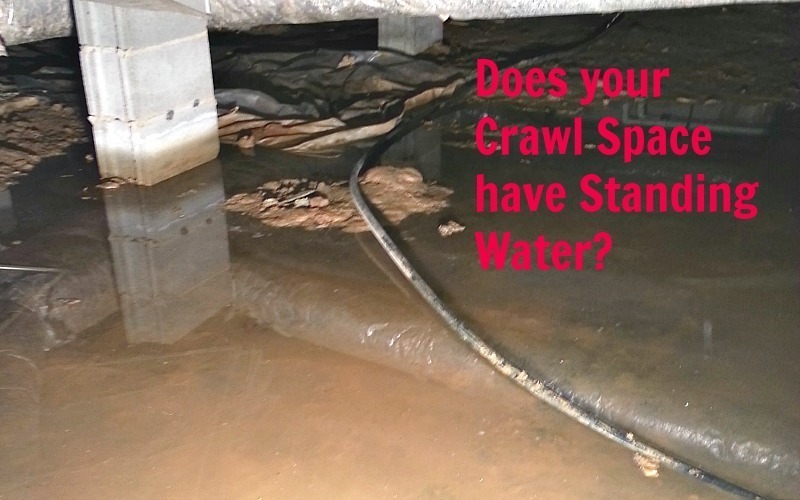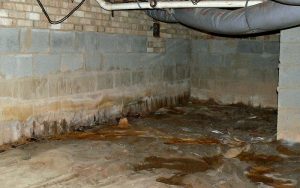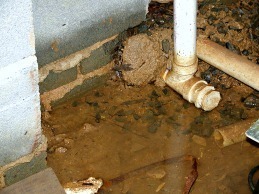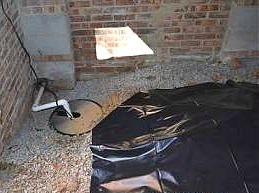Eastern North Carolina Important: COVID-19 Announcement.

Is there a musty smell in your home? Did your pest control exterminator tell you mold is growing on your floor joists? Did your air conditioning technician inform you that it’s wet in your crawl space? Did you take a peek in your crawl space and see standing water? The structural integrity of the home can be jeopardized by a damp or wet crawl space.
 Many crawl spaces have moisture problems.
Many crawl spaces have moisture problems.There might be standing water in the crawl space that has seeped up through the ground. Even if there is no standing water, there could still be excess moisture. Musty smells could signal that mildew or mold is present.
Crawl spaces are easy to ignore but we should not forget that the building components in the crawl space support the entire home. It is important to keep your crawl space dry.
Some of the signs of a moisture problem in your crawl space include:
Prolonged periods of moisture in a crawl space can lead to all sorts of problems with your house and with the health of you and your family. Excess humidity in a crawl space occurs from evaporation of standing water or from excess ground moisture.  This excess humidity can form condensation on wood, metal and other building materials causing rot and rust. Floor framing can become damp causing the floor to sag, slope or buckle. Over time, wood rot can occur and compromise the structural integrity of the home requiring wood framing to be replaced.
This excess humidity can form condensation on wood, metal and other building materials causing rot and rust. Floor framing can become damp causing the floor to sag, slope or buckle. Over time, wood rot can occur and compromise the structural integrity of the home requiring wood framing to be replaced.
In addition, excessive dampness can lead to mold and mildew on wood framing. Mold spores are found everywhere but only cause a problem if the proper conditions are met. Mold feeds on cellulose or wood, but can only grow when there is sufficient moisture.
Mold in a crawl space affects the air in the crawl space and can create musty odors in your house. Most homeowners are not aware that air from the crawl space enters their house. More than just bad odors, mold in your crawl space can create unhealthy indoor air that you and your family breathe.
Excessive moisture in your crawl space can also attract destructive wood-boring insects such as termites.
Moisture can be introduced into a crawl space by several different ways. Plumbing leaks and air conditioning condensation can cause moisture in a crawl space, but there are many other ways water can get into the crawlspace. Standing water can occur in a crawl space after a heavy rainfall. Water can pool around the house before the ground can absorb it.
With no place to go, the water can move under foundation walls and work its way into the crawl space soil. This is called the “clay bowl effect.” In clay soil common in this area, during winter months or periods of extreme wetness the soil can become saturated with more water than it can hold; this water is released in low areas such as your crawl space.
Another significant source of moisture in a crawl space can be exposed soil coupled with insufficient ventilation. Moisture from the soil is emitted causing high humidity and can form condensation on wood, metal and insulation in the crawl space.
To control excess moisture in the crawl space, the solution is to install a drainage system around the perimeter of the crawl space walls. Water that enters the crawl space will be directed through the pipe into the sump pit where a sump pump will force the water out of the crawl space and away from the house.
Any active system needs maintenance and monitoring. Atlantic Foundation & Crawl Space Repair can provide battery backup and monitoring systems for your additional peace of mind.
In addition, covering the entire crawl space floor with a vapor barrier can minimize the amount of ground moisture entering the crawl space. Vapor or moisture barriers must be properly installed to be effective. If there is already a vapor barrier installed, it may need to be repaired or expanded.
Of course, improving drainage around your house with gutters, downspouts and appropriate lot drainage also helps prevent storm water from seeping under your foundation.
Protect your home and your family, your two greatest investments. Inspect your crawlspace! We recommend looking in your crawlspace at least once per season since conditions can change with the seasons. A crawlspace that is dry in the summer may have standing water in the winter. Contact the foundation professionals at the first sign of moisture in your crawl space.
For a free estimate to evaluate the moisture problem in your crawl space, contact Atlantic Foundation & Crawl Space Repair at 919-855-0855.
For more information on home maintenance please Like Us on our Facebook page or Follow Us on Google Plus